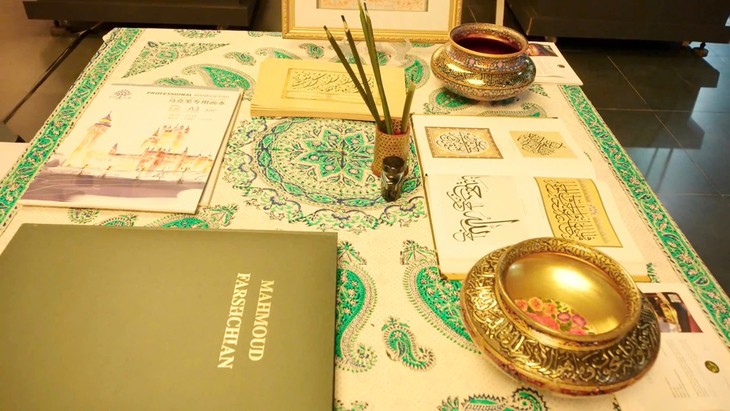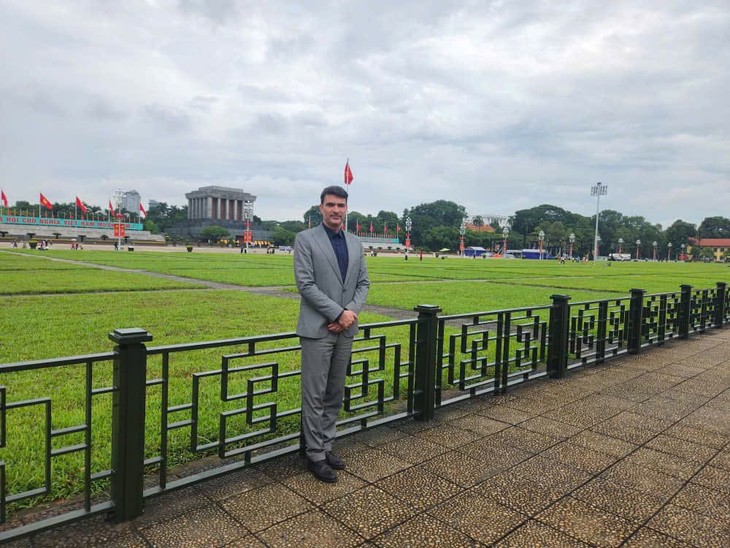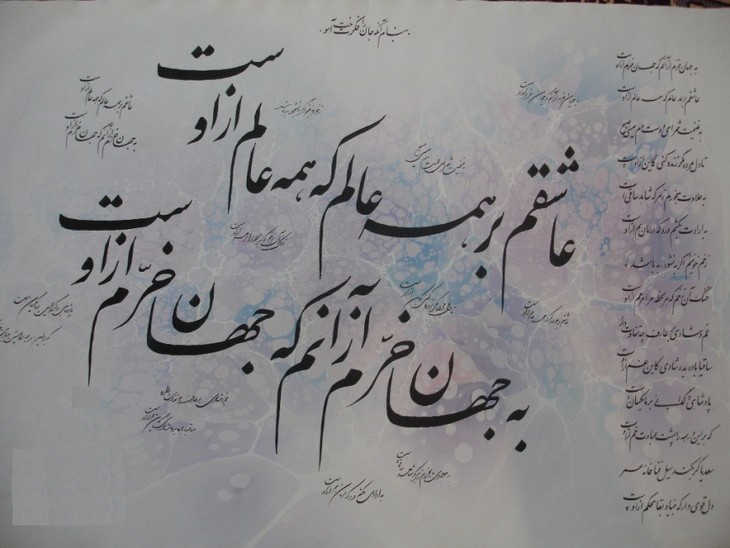(VOVWORLD) - Persian calligraphy is one of the most revered arts throughout Persian history and is an example of fine Persian culture. We had a quick talk to Javad Baskhi, First Secretary of the Iranian Embassy in Hanoi, at the ongoing Iranian arts exhibit "Colors and patterns: the road to Iranian arts" about the traditional arts of Iran.
 (Photo credit: Iranian Embassy in Hanoi) (Photo credit: Iranian Embassy in Hanoi) |
Bao Tram: Welcome to VOV24/7’s Cultural Rendezvous, Mr. Javad Baskhi!
Javad Baskhi: First of all, I should thank your channel for giving me this opportunity to talk with you and with your audience and all those who listen and follow your program.
Bao Tram: Calligraphy is part of the history of Persian history. Could you further elaborate on the art?
Javad Baskhi: The history of Persian calligraphy is rich and ancient. Calligraphy has been an integral part of Persian culture for over a thousand years. The origins of Persian calligraphy can be traced back 2,500 years to the Sasanian period and after Islam spread in our region in West Asia or, as you know it, the Middle East, Iranians adopted the Arabic script and it led into the development of distinctive Persian calligraphic styles.
Bao Tram: What are the principles of Persian calligraphy?
Javad Baskhi: Actually, the principles of the Persian calligraphy are deeply rooted in our philosophical traditions of Iran and Persia. If I want to mention the principles, I should mention harmony and balance, fluidity and movement, symbolism and spirituality, and also geometric principles.
The connection between Persian calligraphy and nature is evident in the way the art from life links to the organic forms and also patterns found in the natural world. Furthermore, I have to say, the mathematic principles underlying Persian calligraphy are deeply influenced by the Islamic tradition of integrating geometry, symmetry, and proportion to artistic expression. This is the interplay between the religious and geometry … mathematics – all these affected how to write Persian calligraphy.
 Javad Baskhi, First Secretary of the Iranian Embassy in Hanoi Javad Baskhi, First Secretary of the Iranian Embassy in Hanoi
|
Bao Tram: How many types of Persian calligraphy are there? What is the hardest calligraphy?
Javad Baskhi: There are several types of Persian calligraphy including Nasta'liq, Shikasteh, Kufic, and Farsi. I think the Shikasteh is generally considered the most beautiful and also the most difficult type of calligraphy. When the masters do the Shikasteh calligraphy, they should be more patient to create a very nice calligraphy writing. The Shikasteh, I think, is the most challenging and demanding from the Persian calligraphy. If you want to learn this type of calligraphy, you should be patient as it would take more time to learn how to write this type of Persian calligraphy, in my opinion.
Bao Tram: In your opinion, is calligraphy a skill or a talent and is it difficult to learn?
Javad Baskhi: It's a good question! Actually, in my opinion calligraphy is both – a skill and a talent, together, yes! While it can be learned and refined through dedicated practice, there is also an inherent creative and artistic ability that contributes to one’s success.
Absolutely all persons can learn how to write calligraphy, but it depends on your willingness to learn and also the dedication to practice. Anyone can develop the skills necessary to create a beautiful calligraphy style.
 Shikasteh is considered the most beautiful and most difficult type among various types of Persian calligraphy. (Photo: persian.religion.ucsb.edu) Shikasteh is considered the most beautiful and most difficult type among various types of Persian calligraphy. (Photo: persian.religion.ucsb.edu)
|
Bao Tram: Have you got any tips for those who want to learn Persian calligraphy?
Javad Baskhi: Actually, first you should have this attitude to learn Persian calligraphy, willingness, patience, and also have a good master. You can learn techniques in the class if you see how the masters write the calligraphy. But it's a little bit difficult because, first of all, you should learn the alphabet, the Persian alphabet, then practice to write by pen or pencil, then try to learn how to write the Persian calligraphy. This is very difficult and needs more time to learn and find the way to write.
Bao Tram: Thank you, Javad Baskhi, for granting VOV this interview.
Javad Baskhi: You're welcome. It's my pleasure to have this time to talk to you and your listeners.